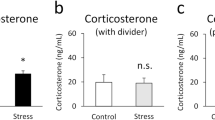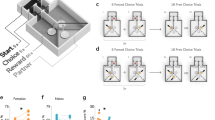Abstract
We showed mice videos of three conspecific social behaviors, namely sniffing, copulation, and fighting, in pairwise combinations using iPods and evaluated preference as determined by time spent in front of each iPod. Mice preferred the copulation video to the sniffing video, the fighting video to the sniffing video, and the fighting video to the copulation video. In Experiment 1a, we used a single video clip for each social behavior but used multiple video clips for each social behavior in Experiment 2a. Next, we trained mice to discriminate between the fighting and copulation videos using a conditioned-place-preference-like task in which one video was associated with injection of morphine and the other was not. For half of the subjects, the fighting video was associated with morphine injection, and for the other half, the copulation video was associated with morphine injection. After conditioning, the mice stayed longer in the compartment with the morphine-associated video. When tested with still images obtained from the videos, mice stayed longer in the compartment with still images from the video associated with morphine injection (Experiment 1b). When we trained mice with multiple exemplars, the subjects showed generalization of preference for new video clips never shown during conditioning (Experiment 2b). These results demonstrate that mice had a preference among videos of particular behavior patterns and that they could discriminate these videos as visual category. Although relationship between real social behaviors and their videos is still open question, the preference tests suggest that the mice perceived the videos as meaningful stimuli.




Similar content being viewed by others
References
Andrews MW, Rosenblum LA (1993) Live-social-video reward maintains joystick task performance in bonnet macaques. Percept Motor Skills 77:755–763
Berlyne EE, Salapatek PH, Gelman RS, Zener SL (1964) Is light increment really rewarding to the rat? J Comp Physiol Psychol 58:148–151
Bird CD, Emethy NJ (2008) Using video playback to investigate the social preferences of rooks, Corvus frugilegus. Anim Behav 76:679–687
Bloomsmit MA, Keeling ME, Lambeth SP (1990) Videotapes: environmental enrichment for singly housed chimpanzees. Lab Anim 19:42–46
Borlongan C, Watanabe S (1994) Failure to discriminate conspecifics in amygdaloid lesioned mice. Pharmacol Biochem Behav 48:677–680
Clark DL, Uetz GW (1999) Video image recognition by the jumping spider Maevia inclemens (Araneae: Salticidae). Anim Behav 40:884–890
D’Eath RB, Dawkins MS (1996) Laying hens do not discriminate between video images of conspecifics. Anim Behav 52:903e912
Deaner RO, Khera AV, Platt ML (2005) Monkeys pay per view: adaptive valuation of social images by rhesus macaques. Curr Biol 15:543–548
Fujita K, Watanabe K (1995) Visual preference for closely related species by Sulawesi macaques. Amen J Primat 37:253–261
Fussa J, Richtera SH, Steinlea J, Deuberta G, Hellwegb R, Gass P (2013) Are you real? Visual simulation of social housing by mirror image stimulation in single housed mice. Behav Brain Res 243:191–198
Grosenick L, Clement T, Femald RD (2007) Fish can infer social rank by observation alone. Nature 445:429–432
Humphrey NK (1972) ‘Interest’ and ‘pleasure’: two determinants of a monkey’s visual preferences. Perception 1:395–416
Ikebuchi M, Okanoya K (1999) Male zebra finches and Bengalese finches emit directed songs to the video images of conspecific females projected onto a TFT display. Zool Sci 16:63–70
Jitsumori M, Natori M, Okuyama K (1999) Recognition of moving video images of conspecifics by pigeons: effects of individuals, static and dynamic motion cues, and movement. Anim Learn Behav 27:303–315
Kish GB (1966) Studies of sensory reinforcement. In: Honig WH (ed) Operant behavior. Appleton-Century-Crofts, New York, pp 109–159
Kliethermes CL, Finn DA, Vrabbe JC (2003) Validation of a modified mirrored chamber sensitive to anxiolytics and anxiogenics in mice. Psychopharmacology 169:190–197
Lambery Y (1998) The mirror chamber test for testing anxiolytics: is there a mirror-induced stimulation? Physiol Behav 64:703–705
Langford DJ, Crager SE, Shezad Z, Smith SB, Sotocinal SG, Levenstadt JS, Chanda ML, Levintin DJ, Mogil JS (2006) Social modulation of pain as evidence for empathy in mice. Science 312:1967–1970
Macedonia JM, Evans CS, Losos JB (1994) Male Anolis lizards discriminate video-recorded conspecific and heterospecific displays. Anim Behav 47:1220–1223
Maloney MA, Leighty KA, Kuhar CW, Bettinger TL (2011) Behavioral responses of silverback gorillas (Gorilla gorilla gorilla) to videos. J Appl Anim Welaf Sci 14:96–108
McGregor PK, Dabelsteen T, Shepherd M, Pedersen SB (1992) The signal value of matched singing in great tits: evidence from interactive playback experiments. Anim Behav 43:987–998
McKinnon JS (1995) Video mate preferences of female three-spined sticklebacks from populations with divergent male colouration. Anim Behav 50:1645–1655
McQuoid LM, Galef BG (1993) Social stimuli influencing feeding behaviour of Burmese fowl: a video analysis. Anim Behav 46:13–22
Mizuno M (1997) Visually-guided discrimination and preference of sexuality in female macaque monkeys. Med J Fukuoka 88:105–116
Montgomery KC (1954) The role of the exploratory drive in learning. J Comp Physiol Psychol 47:60–64
Ord TJ, Christopher SE (2002) Interactive video playback and opponent assessment in lizards. Behav Proc 59:55–65
Paxton R, Basile BM, Adachi I, Suzuki WA, Wilson ME, Hampton RR (2010) Rhesus monkeys (Macaca mulatta) rapidly learn to select dominant individuals in videos of artificial social interactions between unfamiliar conspecifics. J Comp Psychol 124:395–401
Paz-y-Miño CG, Bond AB, Kamil AC, Balda RP (2004) Pinyon jays use transitive inference to predict social dominance. Nature 430:778–781
Rowland WJ, Bolyard KJ, Halpern AD (1995) The dual effect of stickleback nuptial colouration on rivals: manipulation of a graded signal using video playback. Anim Behav 50:267–272
Schwartz GG, Rosenblum LA (1980) Novelty, arousal, and nasal marking in the squirrel monkey. Behav Neural Biol 28:116–122
Sherwin CM (2004) Mirrors as potential environmental enrichment for individually housed laboratory mice. Appl Anim Behav Sci 87:95–103
Shimizu T (1998) Conspecific recognition in pigeons (Columbia livia) using dynamic video images. Behaviour 135:43e53
Takebayashi M, Funahashi S (2009) Monkeys exhibited preference for biologically non-significant visual stimuli. Psychologia 52:147–161
Toubas PL, Abla KA, Cao W, Logan LG, Seale TS (1990) Latency to enter a mirrored chamber: a novel behavioral assay for anxiolytic agents. Pharmacol Biochem Behav 35:121–126
Watanabe S (2002) Preference for mirror images and video image in java sparrows (Padda oryzivora). Behav Proc 60:35–39
Watanabe S (2013) Preference for and discrimination of paintings by mice. PLOSONE 86:e65335
Watanabe S (2014) The dominant/subordinate relation between mice modifies the approach behavior toward a cage mate experiencing pain. Behav Proc 103:1–4
Watanabe S, Aust U (2015) Object and picture perception. In: Call J (ed) APA handbook of comparative psychology. American Psychological Association, Washington, DC (in press)
Watanabe S, Yamashita M, Wakita M (1993) Discrimination of video images of conspecific individuals in Bengalese finches. J Ethol 11:67–72
Wilson FA, Goldman-Rakic PS (1994) Viewing preferences of rhesus monkeys related to memory for complex pictures, colours and faces. Behav Brain Res 60:79–89
Yamazaki Y, Shinohara N, Watanabe S (2004) Visual discrimination of normal and drug induced behavior in quails (Coturnix coturnix, japonica). Anim Cog 7:128–132
Acknowledgments
This research was supported by a Grant-in-Aid for Scientific Research on Innovative Areas, Japan Society for the Promotion of Science (25118001).
Author information
Authors and Affiliations
Corresponding author
Rights and permissions
About this article
Cite this article
Watanabe, S., Shinozuka, K. & Kikusui, T. Preference for and discrimination of videos of conspecific social behavior in mice. Anim Cogn 19, 523–531 (2016). https://doi.org/10.1007/s10071-016-0953-x
Received:
Revised:
Accepted:
Published:
Issue Date:
DOI: https://doi.org/10.1007/s10071-016-0953-x




